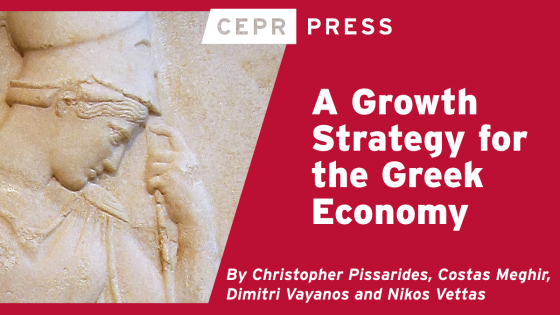Unlike its two predecessors, Greece’s third economic programme has been relatively successful. Since 2015, the country has been enacting most of the conditions attached to its loans. It primary fiscal balance is back in surplus, and growth has resumed. Both the government and its official creditors are hoping that this will allow Greece to return to private market financing after the programme ends in the second half of this year.
Before this can happen, however, Greece will require more official debt relief. The Eurogroup (2017) all but acknowledged this, and suggested a number of potential debt relief measures. These included early repayment of the IMF using cheaper ESM financing and maturity extensions and interest deferrals of €131 billion in loans that Greece owes to the EFSF, its largest official creditor. The European Commission (2018) and IMF (2017) agree that Greece’s debt is not sustainable. In a previous analysis, some of us reached the same conclusion (Zettelmeyer et al. 2017).
What remains controversial, however, is how much debt relief and how it should be delivered. These are the questions we address in a new report published in the CEPR Policy Insight series (Eichengreen et al. 2018). The report has three main takeaways.
- Even the full set of measures considered by the Eurogroup would not be enough to restore the sustainability of Greece’s debt.
- Creditors should consider several options for improving Greece’s debt sustainability – including extending additional official financing for the foreseeable future to prevent new borrowing from expensive private sources, and applying measures of the type considered by the Eurogroup to additional official loans. However, it is unlikely that these measures will make Greece’s debt sustainable unless they are combined with reduction in principal (face value).
- Such reductions could be extended conditionally and gradually over a limited time period in a way that would create incentives for fiscal discipline while being consistent with the‘no bailout’ clause of the EU treaties.
Assumptions
Debt sustainability analysis requires assumptions regarding the path of four variables: the primary budget surplus, the growth rate, the interest rate, and the inflation rate. In the case of Greece, we also need to take into account privatisation proceeds.
While we consider a variety of assumptions, we focus on four scenarios:
- Optimistic growth, 2% surplus. This assumes a steady-state growth rate of 1.25% and a primary surplus path of at least 2% of GDP, consistent with the June 2017 Eurogroup statement. Inflation and privatisation proceeds follow Commission baselines.
- Moderate growth, 2% surplus. Same as the optimistic scenario except that steady-state growth is assumed to be 1.0% (which we view as more realistic than 1.25%, based on an analysis of TFP convergence and demographics in Greece).
- Moderate growth, 1% surplus. This scenario is the same as the previous one, assuming a steady-state GDP growth rate of 1%, but it accepts that the primary surplus eventually declines to 1% of GDP, as in Zettelmeyer et al. (2017).
- IMF. The steady state growth rate is 1% and the primary surplus after 2022 is set at 1.5% of GDP. This scenario assumes lower privatisation revenues and long-term inflation of just 1.8% instead of 2% as in the three previous scenarios.
In all cases, we follow the European Commission (2018) in assuming an interest rate rule based on Laubach (2009), in which private lenders charge a 3 basis-point risk premium (i.e. 0.03%) for every 1% debt-to-GDP above 60%. Based on end-2017 debt levels, this implies a 380 basis-point spread (Greece’s actual spread on the ten-year government bond in early March 2018 was about 355 basis points). We then run Monte Carlo simulations that take explicit account of uncertainty.
We consider that the debt is sustainable if the debt ratio is declining and if the gross financing needs never exceed 20% of GDP between 2019 and 2060 – the same criteria used by the Eurogroup.
We confirm that under the status quo, debt is not sustainable under any of the four scenarios. Part of the reason is that this requires extensive use of market finance at a time when debts and private lending spreads are still high, creating explosive debt dynamics. We then analyse four options for debt relief. The first is the package that the Eurogroup has put on the table, while the next three explore additional ideas.
Full use of debt relief instruments considered by the Eurogroup
Even the full set of “medium-term” debt relief measures considered by the Eurogroup make the debt sustainable only under the scenarios which assume that Greece maintains a primary surplus of 2% or higher for more than 40 years. Such large surpluses extended over such long periods are exceedingly rare (Eichengreen and Panizza 2016). Under somewhat less extreme but still ambitious assumptions, Greek debt is again unsustainable.
While full application of the measures considered by the Eurogroup would not make Greece’s debt sustainable, it could create a period of 15 years or more during which the country’s gross financing needs appear manageable. This does not imply, however, that the decision on additional debt relief can be postponed. During this period, official debts with very low interest rates would increasingly be replaced by private debts with shorter maturities and much higher interest rates, increasing the cost of rollovers and gross financing needs over time. Any future debt relief operation would have to either restructure these debts or accept much deeper official debt relief – in effect, using public money to bail out private creditors – than would be required were action taken to make Greece’s debts sustainable today.
Option I. Face-value debt reduction and incentives
This option combines face-value debt reduction with incentives for the current and future Greek governments to achieve primary surpluses.[1] The incentives are a carrot (matching primary budget over performance with face value reduction) and a stick (a clawback rule in case of underperformance). For every euro that exceeds an agreed minimum primary surplus – for example, 1.5%, the path that the IMF considers realistic – the creditors would provide a euro in debt relief, up to an agreed maximum. If the maximum path is chosen realistically, this would give Greece the incentives to aim for it, leading to better fiscal performance than would otherwise be the case.
This type of conditional face-value debt relief would be consistent with EU law. In a legal appendix to the report, we argue that, based on the European Court of Justice’s decision in the Pringle case, the‘no bailout’clause of the Lisbon treaty should be read as allowing forms of financial assistance – regardless of the instrument used to deliver them – that are structured to improve fiscal discipline.
A plan of this type, even if implemented for a limited period (for example, from 2023 until 2037), can deliver debt sustainability under all scenarios. The amount of face value relief that would be required is fairly modest, about 9% of GDP, partly because of the better fiscal performance it induces.
Option II. Continued ESM financing
This option combines the full set of measures considered by the Eurogroup with continued ESM financing. This improves the debt dynamics by avoiding borrowing from the private sector at a time when this is still very expensive.
But a very lengthy period of recourse to ESM financing would likely be required, implying not just lending but also invasive conditionality over an extended period. This option would also entail a large increase in total European official sector exposure to the country. Our analysis suggests that even extending ESM programmes for an additional 20 years, in combination with EFSF maturity extensions and interest deferrals, may not be enough.
If Greece’s creditors are unwilling or unable to commit to additional debt relief (beyond the measures already considered by the Eurogroup) in the near future, Option II would offer a responsible approach to gambling for redemption. It would be preferable to ending Greece’s access to official financing in 2018. Indeed, it would maintain the option of additional debt relief measures in the future without the need to repay or restructure expensive private debts that would otherwise have accumulated in the meantime.
Option III. Applying the Eurogroup measures to a broader debt base
This option would apply the measures that the Eurogroup is considering for the EFSF – maturity extensions and interest deferrals – to a broader debt base, not just EFSF loans but also the bilateral loans of the 2010 Greek Loan Facility (the bilateral loans from euro area countries extended just before the EFSF was created). Greek Loan Facility repayments are front-loaded and relatively expensive in terms of interest rates. They could be restructured along four dimensions – later start, longer maturities, interest deferrals, and a reduction in the lending spread – without requiring face-value debt reductions.
Our analysis shows that even this may not, by itself, be sufficient to restore the sustainability of Greece’s debt. To achieve debt sustainability, it would be necessary to combine it with either of the two other options (or both). In particular, a combination of Options II and III would suffice to restore debt sustainability. But it would require a very large increase in the total exposure to Greece of the European official sector, with repayments lasting until the end of this century and possibly beyond.
Conclusion
An adjustment and debt relief plan for Greece should be based on realistic assumptions. It should provide Greece with clear incentives to adhere to the programme. So far, the plans sketched by the European official sector fall short of both aims. We have therefore explored three ways of extending the package of medium-term debt relief that the Eurogroup has put on the table. Option I is to add conditional face-value debt relief, trading debt relief for long-lasting fiscal discipline. Option II would substitute relatively economical ESM financing for expensive market financing. Option III would apply the Eurogroup measures not just to EFSF loans but also to the bilateral loans of the 2010 Greek Loan Facility.
Our main result is that while all three options can contribute, only Option I can stand alone. Options II and III together might deliver sufficient debt relief, but this would come at the price of shifting the burden of repayment several generations into the future. Any debt relief package for Greece that wishes to avoid this will need to include some degree of face-value debt relief.
References
Bulow, J and J Geanakoplos (2017), “Greece’s Sovereign Debt and Economic Realism”, CEPR Policy Insight No. 90.
Eichengreen, B and U Panizza (2016), “A Surplus of Ambition: Can Europe Rely on Large Primary Surpluses to Solve its Debt Problem?”, Economic Policy 31(85): 5-49.
Eichengreen, B, E Avgouleas, M Poiares Maduro, U Panizza, R Portes, B Weder di Mauro, C Wyplosz and J Zettelmeyer (2018), “Independent report on the Greek official debt”, CEPR Policy Insight No. 92.
European Commission (2018), Compliance Report, ESM Stability Support Programme for Greece. Third Review, January.
Eurogroup (2017), “Eurogroup Statement on Greece”, 15 June.
International Monetary Fund (2017), Greece: Request for Stand-By Arrangement. Country Report 17/229, July.
Laubach, T (2009), “New Evidence on the Interest Rate Effects of Budget Deficits and Debt”, Journal of the European Economic Association 7(4): 858-885.
Zettelmeyer, J, E Kreplin, and U Panizza (2017), “Does Greece Need More Official Debt Relief? If So, How Much?”, Working Paper 17-6, Peterson Institute for International Economics.
Endnotes
[1] An alternative incentive-compatible scheme has been proposed by Bulow and Geanakoplos (2017).









